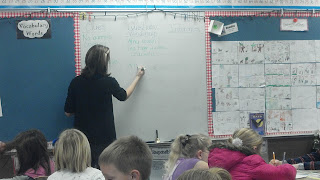 The last couple of weeks of school Mrs. Maxwell and her students worked on what it means to make inferences, something that kids do intuitively, but a kind of thinking that can be tricky to label. They've read a variety of mysteries, but one has quickly become a favorite: The Mary Celeste: A Mystery from History, by Jane Yolen. This book shares the facts of the mysterious disappearance of the crew in the 1800s. It's great fun to watch just how engaged the kids become as they discuss possible theories.
The last couple of weeks of school Mrs. Maxwell and her students worked on what it means to make inferences, something that kids do intuitively, but a kind of thinking that can be tricky to label. They've read a variety of mysteries, but one has quickly become a favorite: The Mary Celeste: A Mystery from History, by Jane Yolen. This book shares the facts of the mysterious disappearance of the crew in the 1800s. It's great fun to watch just how engaged the kids become as they discuss possible theories.This year as I was observing I noticed that Mrs. Maxwell was using a great anchor activity.
 |
| Mrs. Maxwell discussing what students will record as they read. |
This thinking activity is simple, but asks students for some very complex thinking. First, as students read they must record clues that they find. This is an excellent lesson as they begin to differentiate between facts and other kinds of thinking. They also have a place to record any questions that they have as they are reading. Some of these will find answers and others will not. (I'm really beginning to learn how important this idea is for young readers and writers. These unanswered questions are wonderful inquiries of nonfiction writing topics!) Lastly, the kids can list any inferences they make.
 |
| Mrs. Maxwell models the strategy. |
Mrs. Maxwell did a fabulous job of modeling the use of this strategies with the kids beforehand. Using their own sheet (a simple notebook paper that they organized) students shared ideas and recorded as a class. Then after a few practice ideas she set them loose. The kids worked intently making focused comments to neighbors and thinking out-loud about their own theories.
 This is an activity worth trying with your advanced 3rd graders as you move toward the learning target of inference. The anchor book is highly engaging and the activity quickly reveals which students are proficient with understanding and naming an inference.
This is an activity worth trying with your advanced 3rd graders as you move toward the learning target of inference. The anchor book is highly engaging and the activity quickly reveals which students are proficient with understanding and naming an inference.Mrs. Maxwell's class is also moving on to the use of The Mysteries of Harris Burdick and The Chronicles of Harris Burdick (NEW!) as they continue in their thinking about inferences. If you'd like more on this activity or the books discussed let me know!








